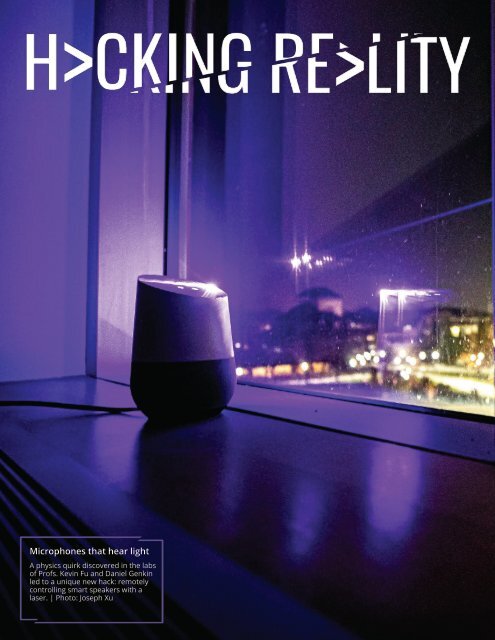Code Blue, issue 1.0
News from Computer Science and Engineering at the University of Michigan.
News from Computer Science and Engineering at the University of Michigan.
Create successful ePaper yourself
Turn your PDF publications into a flip-book with our unique Google optimized e-Paper software.
Microphones that “hear” light; microprocessors that “tell” us<br />
secrets; self-driving cars that “see” fake objects; sensors that<br />
“feel” the wrong temperature. Our devices are under attack in<br />
new, increasingly sophisticated ways. Security researchers at CSE<br />
are exploring the limits of hardware and finding new, sobering<br />
vulnerabilities in our computers and homes.<br />
Where does “computer” end, and “real world” begin? This line,<br />
separated so firmly in our minds by apps and user interfaces, is<br />
finer than it appears.<br />
Our computers aren’t bounded by programs, but by physics: the<br />
electrons flowing between a microprocessor and memory; device<br />
ports and wireless receivers; microphones, wires, speakers, screens,<br />
and other channels along which signals travel or cross from one<br />
medium into another. While programmers often categorize hardware<br />
as externalities that they don’t have to worry about, their programs<br />
are ultimately running on real-world machines with real-world<br />
imperfections.<br />
With the widespread adoption of smart speakers, security cameras<br />
and vision systems, and embedded systems, the distinction gets even<br />
hairier — computers are suddenly a lot more perceptive than we’re<br />
used to, and the edges between computer and reality become viable<br />
channels for input. In tandem with this, microprocessors themselves<br />
have turned increasingly to clever tricks to achieve better performance<br />
without considering the observable side effects that start to manifest<br />
in the real world.<br />
Microphones that hear light<br />
A physics quirk discovered in the labs<br />
of Profs. Kevin Fu and Daniel Genkin<br />
led to a unique new hack: remotely<br />
controlling smart speakers with a<br />
laser. | Photo: Joseph Xu<br />
With this complexity in function come new avenues for hacking attacks.<br />
In a hypothetical closed computer, walled off from real-world physics,<br />
the weak points are code and human behavior. Trick someone<br />
>><br />
>36 //C0DE BLUE<br />
//C0MPUTER SCIENCE AND ENGINEERING AT MICHIGAN<br />
>37



